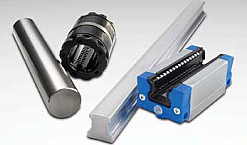
How to choose a linear rail and carriage for linear motion
By Danaher Motion
Motion Control Power Transmission bearings LinearThe way you look at linear bearings can change the way your motion products appear, and more importantly, the way they behave.

By Al Ng, Marketing Manager; Pat Rocco, Product Manager, Profile Rails; Dave Roth, Product Manager, Round Rails; and John Bandowski, Chief Engineer, at Thomson, A Danaher Motion Company
Linear rails come in basically two types, round and square. The criteria for choosing one over the other is no different than choosing any other machine component; spec out the design, define the system’s objectives, and work from past successes and mistakes. But anyone short on experience can make more mistakes, so a condensed course in selecting the proper rail for any application to keep design errors to a minimum is in order. The best place to start is learning the fundamental characteristics of each type, and adopting those that are most relevant to the application.
Round-rail technology has been honed to near perfection over the past 60 years and square profile rails a respectable 35. Both have definitely matured and most of the inherent design problems have long been ironed out. Materials have improved dramatically and the fi nest engineers have shaped linear rail technology into an “exact science.” Most problems arise from misuse and misapplication. And the main reasons for misapplication often come from a personal bias or prejudice, a miscalculation, or an esthetic judgment. That is, a relatively small linear profile rail might fi t the load, speed, and every other requirement just fine, but when it’s mounted to the machine, a discerning eye might conclude that it looks feeble, definitely undersized.
One type of linear ball bushing guide is not necessarily easier to use than another, the choice depends entirely on the specific application. In general, a particular square- rail component might cost more than the round, but other requirements and the total system cost need to be addressed. At a minimum, these items include the expenses for preparing the machine bed (or other mounting surface) to accommodate the rail system, the positioning accuracy needed, and the total spatial environment available for the linear rail subsystem.
But before committing pencil to paper or mouse to pad, decide upon either a square or round rail. When the application looks like it could go either way, run preliminary calculations on the most critical characteristics and requirements gleaned from the following discussion and manufacturer’s catalogs to make certain nothing is overlooked.
